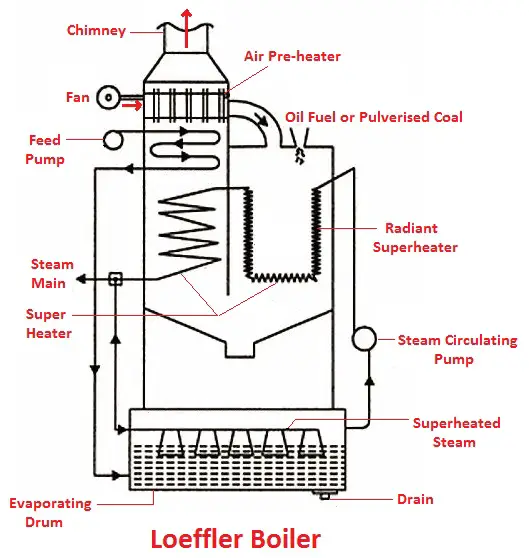Loeffler Boiler
The Loeffler boiler is an addition of the Lamont boiler. In LaMont boiler, a major problem was experienced which is the salt and sediment deposition in the inner surface of the water tube through which water the flows.
This deposition of salt and sediment decreases the heat transfer in the inner surface area of the water tube. LaMont boilers also have overheating problems due to the salt deposits. For these problems of La Mont boilers have been solved with the Loeffler boiler by preventing the flow of water in the tubes.
The Loeffler boiler is an internally fired furnace with forced circulation, high pressure and water tube boiler. In Loeffler boiler, 75% of superheated steam is used to evaporate the water within the evaporator drum and the remaining 25% of the steam from the superheater is utilised by the turbine. Steam circulating pump is employed to circulate steam inside the boiler.
Working Principle of Loeffler Boiler
Its main working principle is to evaporate the feed water by means of superheated steam from the superheater. The hot gases from the furnace are used for superheating. The total produced superheat steam is used in two ways. About 75% is used to evaporate the water and 25% is used to drive the prime mover of the turbine.
Read also:
- Boiler Mountings and Accessories: Types, and Their Working
- Steam Boilers: Parts, Types, Classification, Advantages, Application, and More
Parts of Loeffler Boiler
The following are the parts of a Loeffler boiler:
- Economiser
- Evaporating drum
- Steam circulating pump or centrifugal pump
- Radiant superheater
- Convection superheater
- Mixing nozzle
1. Economiser
Economizer is used to heating the water before it is entering into the drum. The process of preheating water increases the overall efficiency of the boiler.
2. Evaporating Drum
The evaporating drum is placed at the bottom of the boiler. It has a mixing nozzle. In this, the feed water is transformed into saturated steam with the help of superheated steam in the superheater.
3. Steam Circulating Pump
Steam circulating pump is also known as centrifugal pump. It exists between evaporating drums and radiant superheaters. It transmits steam in the boiler.
4. Radiant Superheater
In radiant superheater, It superheats steam by the method of radiation generated by the burnt fuel in the boiler.
5. Convection Superheater
In the convection superheater, it superheats steam by the method of convection to the desired temperature of about 500° C.
6. Mixing Nozzle
It is located inside the evaporated drum. It mixes the steam and feed water from the superheater and evaporates them.
Working of Loeffler Boiler
A diagrammatic sketch of a Loeffler boiler is shown in the figure. The feed water from the economiser tubes is forced to mix with the superheated steam in the evaporating drum.
In the evaporator drums, nozzles are provided. The two-thirds (70%) of superheated steam from the superheater enters into the drum nozzles. The nozzles mix this superheated steam with feed water. This converts the feed water into the saturated steam.

The saturated steam, thus formed, is drawn from the evaporating drum by a steam circulating pump. This allows the saturated steam to pass through the radiant superheaters. In radiant superheater, It superheats steam by the method of radiation produced by the burnt fuel in the boiler. Heat transfer to water occurs through the radiation produced.
After the radiant superheater, steam is routed to the convection superheater. Convection superheater is located in the path of hot exhaust gases. In the convection superheater, it superheats steam by the method of convection to the desired temperature of about 500° C.
This steam then passes through the tubes of the combustion chamber walls and then enters the superheater. From the superheater, about one-third (30%) of the superheated steam passes to the turbine and the remaining two-thirds (70%) is used to evaporate the feed water in the evaporating drum.
The Loeffler boiler has the capability to generate 100 tons/hour of steam at a temperature of 500° C and a pressure of 140 bar.
Advantages of Loeffler Boiler
The following are the advantages of Loeffler boiler:
- Able to carry high salt concentration for steam generation.
- The problem of sedimentation and scale deposition in boiler tubes is fully eliminated.
- This boiler is compact in design.
- The high flow of steam on the tubes.
- The operation of the boiler is clean and salient.
Disadvantages of Loeffler Boiler
The following are the Loeffler boiler:
- The bubble formation decreases the heat transfer rate.
- The evaporating drum is used which improves the overall cost and also makes it heavier.
FAQ
Its main working principle is to evaporate the feed water from the superheater through the superheated steam. The hot gases coming out of the furnace are used for superheating.
It is capable of carrying high salt concentrations for steam generation. The issue of sedimentation and scale deposition in boiler tubes is fully eliminated.
That’s it. Thanks for reading. If you have any questions or doubts about “Loeffler boiler” ask in the comments I’ll respond to it. If you found this article helpful please share with your friends.
Subscribe to our newsletter to be notified when we upload new posts. it’s free.
Read more boiler here: